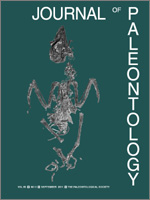A new species of stem parrot is reported from the early Eocene Fossil Butte Member of the Green River Formation. Well-preserved specimens including a complete skeleton and referred partial postcranial skeleton reveal new osteological details of the clade Halcyornithidae and expand the known diversity of the Green River avifauna. Cyrilavis colburnorum n. sp. shares key morphologies with the smaller Green River halcyornithid Cyrilavis olsoni. A combined phylogenetic analysis of Pan-Psittaciformes using 101 morphological characters and sequence data from three genes (RAG-1, Z-chromosomal spindlin and cytochrome b) supports the placement of 1) Halcyornithidae, 2) a small clade uniting the Messel fossil taxon Psittacopes lepidus and an unnamed London Clay species, and 3) Quercypsittidae on branches successively closer to the crown clade Psittaciformes. Analysis of the morphological dataset alone yields a similar strict consensus tree with slightly less resolution (one additional branch collapsed). Relationships within the crown clade agree well with recent hypotheses in supporting a basal divergence between the New Zealand Nestoridae and all other extant parrots, and a second major divergence between Cacatuidae and Psittacidae. When fossils are taken into account, many previously proposed synapomorphies of extant parrots are instead optimized as synapomorphies of more inclusive groups including both stem fossil taxa and living taxa. Fossil evidence is consistent with a more recent origin of crown clade Psittaciformes than predicted from divergence dating analyses, and supports environmental shifts and dispersal as key drivers in parrot biogeography.
How to translate text using browser tools
1 September 2011
Stem Parrots (Aves, Halcyornithidae) from the Green River Formation and a Combined Phylogeny of Pan-Psittaciformes
Daniel T. Ksepka,
Julia A. Clarke,
Lance Grande
ACCESS THE FULL ARTICLE

Journal of Paleontology
Vol. 85 • No. 5
September 2011
Vol. 85 • No. 5
September 2011




